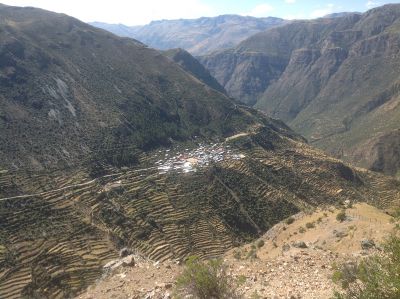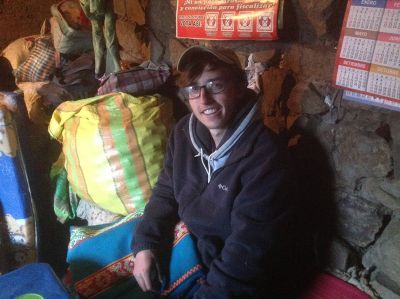A Death in Vito

Philip shares a journal entry. He and Hayley served in the remote town of Vito, three hours along a twisty, bumpy dirt road from the small city of Chalhuanca, in the state of Apurímac.
The sun was shining high in Vito when the officials finally came to inspect the body. Hayley and I arrived on the scene as well, having just eaten lunch. Earlier that morning, over breakfast, we had heard about the woman who fell.
The official record keeper was a man named George, whom Hayley and I met as we walked down to the stadium to catch up with the rest of the party. When he found out we were studying pre-medicine, he allowed us to come down and inspect the body with Ruben (an on-site nurse in Vito) and Mills (a doctor from Mollebamba). George was from Antabamba, as was the rest of the team: other officials, and a young army man with a pistol. A few neighbors came to help move the body.
A teenage boy had found her in the early hours of the morning. They deduced that she fell off the cliff around 4:30 a.m. while returning from her field. When I first saw her, she looked as though she were taking a nap. She was dressed typically as a woman of her age: heavy skirt and a few layers of sweaters, all bright colors. The way she was lying at the base of the cliff made it seem as though she were merely sunbathing in the afternoon.
Yet on closer inspection you could see her shoes were knocked off, her wrist jutted out in an odd direction, her palms were bloodied; and the serene look on her face appeared more grimace than content. Someone called out from on top of the 12-meter cliff. They had found her hat.
Scissors were called for, to cut away her clothes. When none were brought forward, a pocketknife appeared and the doctor used that. She was old, tan and wrinkly. Her skin was stretched tight over her small, thin legs. She was the size of a child and before long as naked as a baby. They inspected all over her body for lesions and bruises.

The cause of death appeared to be a fractured skull or internal bleeding. Probably both. It was then that the secretary began asking pointed questions to her sons. Did she have any quarrels with her neighbors? Do the brothers get along? Did she plan on leaving an inheritance? If so, who stood to gain?
It had never occurred to me that this could be a murder. I looked up at the hill to see a gathering of people come to watch the proceedings. This was Vito. There was no way she was murdered. Still, questions had to be asked.
When she was finally picked up and moved, her arms and legs were stiff and unflexible. She looked like a beautifully prepared mummy. When they pulled on her arm, there was a sickening crunch. I thought for certain her arm was dislocated, but it was only the gravel grating underneath her as she rolled over.
The examination took all afternoon. If at first I was uncomfortable looking at a cadaver, by the end I wasn’t bothered at all. They had to shoo away some boys who snuck down and were peering over the fence. The sun was dropping lower in the sky when we went up to town. Soon it would be dark.
Her death was a reminder that cold and infections and malnutrition were not the only ways that people died here in the mountains. Falling is just as deadly, and there are many mountain paths.




